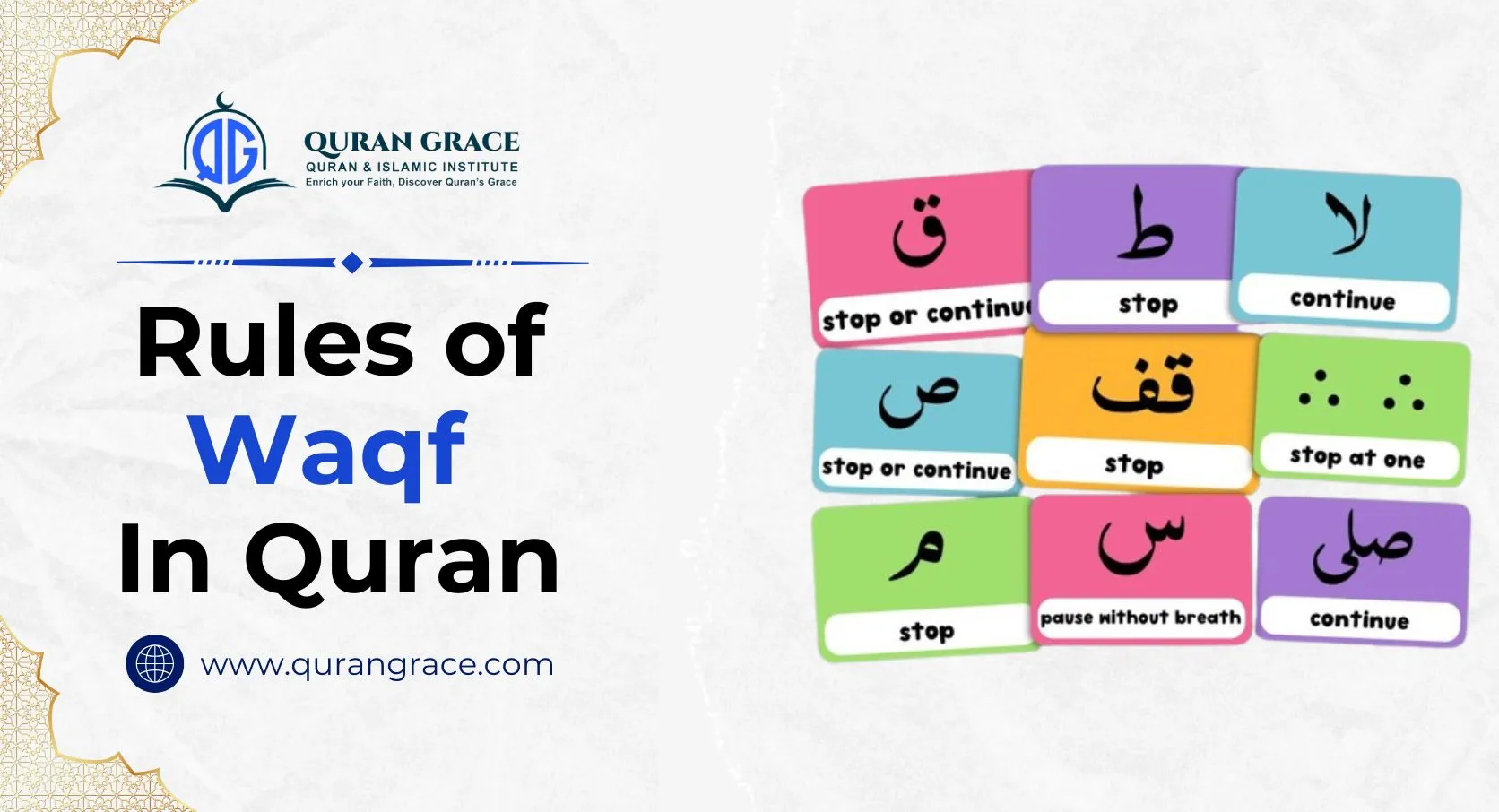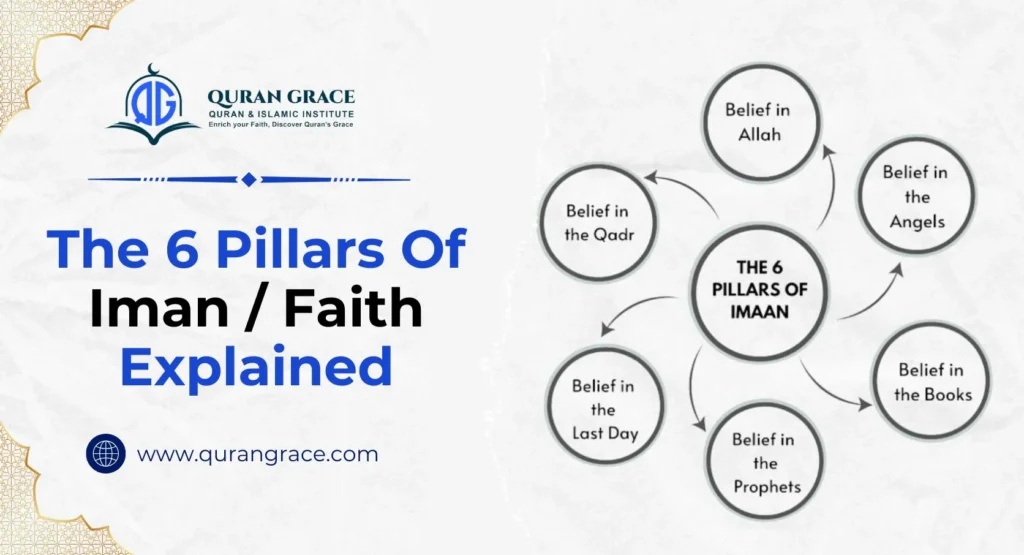Many individuals stumble when reading the Quran due to a lack of understanding of Waqf rules, a guide that helps the reader when to stop or pause during recitation. There are various types of Waqf, including Waqf e Lazim and Waqf e Taam, and grasping these concepts is essential for reading the Quran both accurately and with reverence.
Each Waqf rule serves a specific purpose within the text. For instance, Waqf e Lazim indicates that we must pause, while Waqf e Taam signifies a complete stop. By mastering these quran reading rules, we can engage with the Quran more effectively and connect deeply with its profound message.
Table of Contents
ToggleWaqf Rules (Rules of Stopping In the Quran) in Tajweed
1. Waqf Taam (Complete Stop) – م
- Symbol: م (Maqtu’a)
- Description: This stop indicates that the meaning of the verse is complete, making the idea fully independent of what follows.
- Usage: It is best to pause here, allowing for a full stop in the recitation before beginning a new thought.
2. Waqf Kafi (Sufficient Stop) – ك
- Symbol: ك
- Description: This stop indicates that the meaning is complete, but the verse is connected to what follows.
- Usage: It is preferred to stop here but with an awareness of the continuation of meaning in the next verse.
3. Waqf Hasan (Good Stop) – ح
- Symbol: ح
- Description: Although the following section provides context, it is acceptable to stop here because the meaning is complete.
- Usage: Pausing is a good thing, but it is also okay to keep going.
4. Waqf Laazim (Necessary Stop): م or لا
- Symbol: م (Laazim) or لا
- Description: A necessary pause is essential to avoid misrepresenting meaning. Continuing without it risks a loss of meaning or incorrect interpretation.
- Usage: A stop is required to avoid changing the intended meaning.
5. Waqf Qabih (Bad or Forbidden Stop)
- Symbol: None (self-evident in recitation)
- Description: Stopping at these moments distorts the meaning and causes misunderstandings.
- Usage: To keep the meaning clear and flowing, do not pause at these points.
6. صلي Al-Wasl Awlaa
- Indicates that, while a stop is possible, it’s better to continue reciting without a pause for a smoother meaning.
7. (Optional Stop): ق Qeela ‘Alayhil-Waqf
- Encourages stopping here, but the reciter is free to choose. Often used at natural pauses in the text.
8. (Brief Pause) – سكته Saktah
- By focusing on the following words and pausing briefly without taking a breath, the recitation is kept flowing.
9. (Permissible Stop) – Waqf e Jaaiz
- Allows for a pause but doesn’t make it necessary. It indicates flexibility in the recitation.
Rules Of Waqf In The Quran With Examples
In Tajweed, understanding waqf rules is crucial for proper Quran recitation. These rules indicate the appropriate moments to pause or stop, helping to keep the meaning of the verses clear and accurate. Incorrect pauses can change the intended meanings, highlighting the importance of these rules in recitation. Below is a summary of the main waqf rules in Tajweed and their corresponding symbols, meanings, and examples as they appear in the Quran. There are a total of 18 rules of wakf, and upon learning them with proper application, you can easily recite Quran beautifully like a pro (without any apparent or hidden mistakes). Enrolling in an online tajweed course can help you master these tajweed rules effectively and improve your Quran recitation skills.
| Waqf rule | Explanation | Example |
| ⃝ – Waqf e Taam | A regular pause where you stop briefly. | “قَالَ ٱلَّذِى جَعَلَ لَكُمُ ٱلۡأَرۡضَ قَرَٲرٗا وَٱسِلَـٰهَۤا” |
| مـ – Waqf e Lazim | A mandatory stop, where you must pause. | “وَٱللَّهُ خَذُولُ غَفُورٌ۬” |
| ط – Waqf e Mutlaq | A complete, unrestricted pause. | “ٱعۡبُدُواْ رَبَّ هَـٰذَا ٱلۡبَيۡتِ” |
| ج – Waqf e Jaaiz | A permissible pause, but not mandatory. | “قُلۡ مَا كُنتُ بِدۡعٗا مِّنَ ٱلرُّسُلِ وَمَآ أَدۡرِى مَا يُفۡعَلُ بِى وَلَا بِكُمۡۖ” |
| ز – Waqf e Mujawwaz | A pause that’s more extended than permissible. | “فَفَهَّمۡنَـٰهَا سُلَيۡمَـٰنَۖ” |
| ص – Waqf e Murakh-Khas | A specific pause for emphasis. | “وَلَوۡ نَشَآءُ لَبَعَثۡنَا فِى ڪُلِّ قَرۡيَةٍ۬ نَّذِيرٗا” |
| صلي – Al-Wasl Awlaa | Stopping at “صلي” but preferable to continue. | “ٱلسَّمَآءِ وَٱلطَّارِقِ” |
| ق – Qeela ‘Alayhil-Waqf | Pause after “ق” but not mandatory. | “فَمَاذَا بَعۡدَ ٱلۡكُفۡرِ” |
| صل – Qad Yusal | Stopping at “صل” with a pause. | “أَفَلَا تَنظُرُونَ” |
| قف – Qif | A full stop where you must pause. | “كَفَرَتۡ قَبۡلُہُمۡ قَوۡمُ نُوحٖ” |
| س – Saktah | A light pause, similar to “ج”. | “فَكَيۡفَ كَانَ عَذَابِى وَنُذُرِ” |
| وقفتہ – Waqfah | Pausing at the end of a verse. | “فَلَنُقۡصِرُنَّهُ ۥ عَلَىٰ نَفۡسِهِۦۖ” |
| لا – Laa | A pause without a pause. | “لَا تُدۡرِكُهُ ٱلۡاَبۡصَـٰرُ” |
| ك – Kadhaalik | Another way to pause without a pause. | “كَذَّبَتۡ عَادٞۖ” |
| ∴ – Mu’anaqah | A momentary pause or hesitation. | “وَلَا نَقُولُ إِلَّا ٱخۡتَلَفَتۡ رُءُوسُنَا” |
| قف النبی – Waqf-un-Nabi | Pause where Prophet Muhammad stopped. | “وَٱللَّهُ عَلِىمٌ حَكِيمٞۖ” |
| قف غفران – Waqf e Ghufraan | Pause when seeking forgiveness. | “وَإِن تُطِعۡ أَڪۡثَرَ مَن فِى ٱلۡأَرۡضِ يُضِلُّوكَ عَن سَبِيلِ ٱللَّهِۚ” |
| قف منزل – Waqf e Manzil | Pause at significant points in the Quran. | “قَدۡ كَذَّبَتۡ قَبۡلَهُمۡ قَوۡمُ نُوحٖۖ” |
A Quick Review of Stop Signs in the Quran
- Understanding where to pause and stop while reciting the Quran requires not only a solid grasp of the Arabic language but also a deep knowledge of Tafseer, or interpretation, to convey the verses’ intended meanings accurately, without distortion.
- The stop signs in the Quran serve similar functions to traffic signs on the road. They guide readers on when stopping is mandatory when stopping is forbidden, and when it is permissible to pause. These signs play a critical role in preserving the integrity of the Quranic verses, ensuring that the meanings remain intact and unchanged.
- Misplacing a stop or failing to observe these signs can potentially lead to misinterpretations, where the nuances of the text could be lost or entirely misconstrued.
- For instance, consider what happens when a reader pauses incorrectly. If one stops after the word (رَبّ) in the verse (الْحَمْدُ لِلهِ رَبِّ العَالَمِين), the meaning is rendered incomplete, leaving the listener yearning for the continuation that gives full context. Such a pause would convey only a fragment of the verse’s significance, thus failing to encapsulate its rich meaning.
Conclusion
Understanding the rules of Waqf in Tajweed is essential for accurate Quran recitation. These guidelines indicate where to pause, ensuring that the message remains clear and accurate. Aspiring students can take a free trial class with Quran Grace to see how the professionals from Egypt help non-natives master recitation skills by learning Wakf rules efficiently. So, join tajweed classes for adults, tajweed for children, and online tajweed classes for sisters to discover and develop your skills and enhance your quran learning today.








